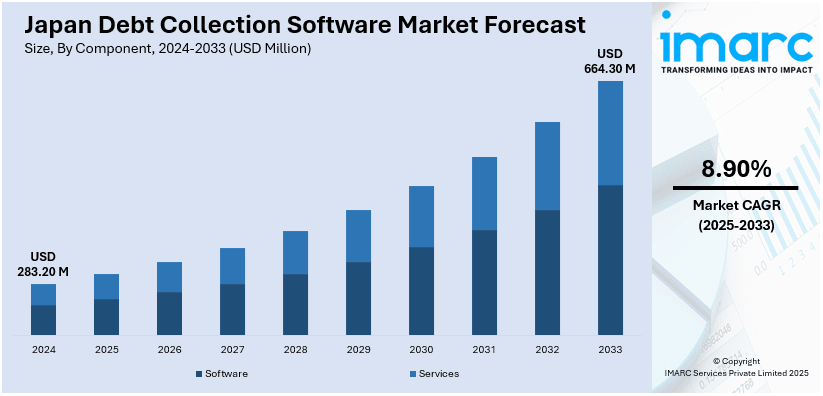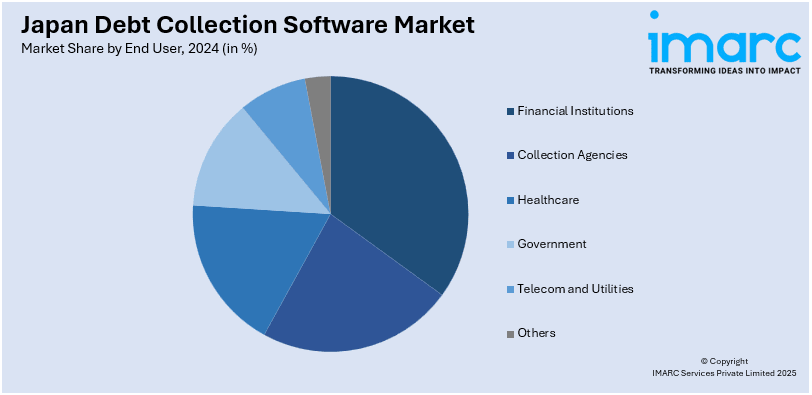
Japan Debt Collection Software Market Size, Share, Trends and Forecast by Component, Deployment Mode, Organization Size, End User, and Region, 2025-2033
Japan Debt Collection Software Market Overview:
The Japan debt collection software market size reached USD 283.20 Million in 2024. Looking forward, IMARC Group expects the market to reach USD 664.30 Million by 2033, exhibiting a growth rate (CAGR) of 8.90% during 2025-2033. The market is driven by the escalating demand for automation, rising adoption of AI-powered analytics, and the growing need for efficient multichannel collection strategies.
|
Report Attribute
|
Key Statistics
|
|---|---|
|
Base Year
|
2024
|
|
Forecast Years
|
2025-2033
|
|
Historical Years
|
2019-2024
|
| Market Size in 2024 | USD 283.20 Million |
| Market Forecast in 2033 | USD 664.30 Million |
| Market Growth Rate 2025-2033 | 8.90% |
Japan Debt Collection Software Market Trends:
Digital Transformation and Automation in the Financial Sector
One of the key driving forces of Japan's debt collection software market is the country’s continued drive toward digital transformation, and more so within the financial sector. Japanese financial institutions, long dependent on manual operations and legacy infrastructures, are extensively adopting automation to improve operational efficiency and minimize human errors. This is being driven by Japan's overall digitalization strategies under programs like "Society 5.0", which aims for the embedding of digital technologies in every sphere of society and business. Debt collection is a process that incorporates enormous administrative work, paperwork, and communication. Automation through sophisticated software tools facilitates these processes by incorporating capabilities like AI-powered risk scoring, automated payment reminders, data analytics, and real-time reporting. These features shorten collection cycles and administrative expenses while enhancing recovery rates. Regulations compliance modules integrated into contemporary software platforms also assist companies in complying with changing financial and data protection rules in Japan, like those defined in the Act on the Protection of Personal Information (APPI).

Rising Consumer Debt and Changing Credit Behavior
Another driver fueling the Japan debt collection software market is the growth in consumer debt as well as the development of credit behaviors by individuals. Whereas Japan has historically been regarded as a high savings rate and conservative borrowing nation, in recent years there has been a reversal. These include flat wages, higher living expenses, and increased credit card and electronic payment usage, which have resulted in higher levels of personal debt, especially among younger and middle-aged populations. Such a transformation has added new challenges for lenders, utility providers, telecommunications companies, as well as even retail outlets which provide credit-backed purchases. While default risks elevate, the priority is to provide sophisticated, scalable, and effective debt collection machinery. Debt collection software provides intelligent tools to manage delinquent accounts, split debtors as per risk profile, and trigger targeted communication measures like SMS, email, or chatbot dialogues, creating higher engagement along with better success in collections.
Japan Debt Collection Software Market Segmentation:
IMARC Group provides an analysis of the key trends in each segment of the market, along with forecasts at the region/country level for 2025-2033. Our report has categorized the market based on component, deployment mode, organization size, and end user.
Component Insights:
- Software
- Services
The report has provided a detailed breakup and analysis of the market based on the component. This includes software and services.
Deployment Mode Insights:
- On-Premises
- Cloud-Based
A detailed breakup and analysis of the market based on the deployment mode have also been provided in the report. This includes on-premises and cloud-based.
Organization Size Insights:
- Small and Medium Enterprises
- Large Enterprises
The report has provided a detailed breakup and analysis of the market based on the organization size. This includes small and medium enterprises and large enterprises.
End User Insights:

- Financial Institutions
- Collection Agencies
- Healthcare
- Government
- Telecom and Utilities
- Others
A detailed breakup and analysis of the market based on the end user have also been provided in the report. This includes financial institutions, collection agencies, healthcare, government, telecom and utilities, and others.
Regional Insights:
- Kanto Region
- Kansai/Kinki Region
- Central/Chubu Region
- Kyushu-Okinawa Region
- Tohoku Region
- Chugoku Region
- Hokkaido Region
- Shikoku Region
The report has also provided a comprehensive analysis of all the major regional markets, which include Kanto Region, Kansai/Kinki Region, Central/Chubu Region, Kyushu-Okinawa Region, Tohoku Region, Chugoku Region, Hokkaido Region, and Shikoku Region.
Competitive Landscape:
The market research report has also provided a comprehensive analysis of the competitive landscape. Competitive analysis such as market structure, key player positioning, top winning strategies, competitive dashboard, and company evaluation quadrant has been covered in the report. Also, detailed profiles of all major companies have been provided.
Japan Debt Collection Software Market News:
- February 2024: Credit Engine, Inc., a Tokyo-based provider of online lending systems, introduced an AI Negotiation Chat feature within its "CE Collection" debt management and collection service. This innovation aims to enhance customer service and improve efficiency in managing overdue receivables by automating repayment consultations and leveraging generative AI for continuous quality improvement.
- April 2023: Credit Engine Asia, a subsidiary of Tokyo-based Credit Engine, Inc., initiated a Proof of Concept (PoC) with SP Madrid, a leading debt collection company.
Japan Debt Collection Software Market Report Coverage:
| Report Features | Details |
|---|---|
| Base Year of the Analysis | 2024 |
| Historical Period | 2019-2024 |
| Forecast Period | 2025-2033 |
| Units | Million USD |
| Scope of the Report |
Exploration of Historical Trends and Market Outlook, Industry Catalysts and Challenges, Segment-Wise Historical and Future Market Assessment:
|
| Components Covered | Software, Services |
| Deployment Modes Covered | On-Premises, Cloud-Based |
| Organization Sizes Covered | Small and Medium Enterprises, Large Enterprises |
| End Users Covered | Financial Institutions, Collection Agencies, Healthcare, Government, Telecom and Utilities, Others |
| Regions Covered | Kanto Region, Kansai/Kinki Region, Central/Chubu Region, Kyushu-Okinawa Region, Tohoku Region, Chugoku Region, Hokkaido Region, Shikoku Region |
| Customization Scope | 10% Free Customization |
| Post-Sale Analyst Support | 10-12 Weeks |
| Delivery Format | PDF and Excel through Email (We can also provide the editable version of the report in PPT/Word format on special request) |
Key Questions Answered in This Report:
- How has the Japan debt collection software market performed so far and how will it perform in the coming years?
- What is the breakup of the Japan debt collection software market on the basis of component?
- What is the breakup of the Japan debt collection software market on the basis of deployment mode?
- What is the breakup of the Japan debt collection software market on the basis of organization size?
- What is the breakup of the Japan debt collection software market on the basis of end user?
- What are the various stages in the value chain of the Japan debt collection software market?
- What are the key driving factors and challenges in the Japan debt collection software?
- What is the structure of the Japan debt collection software market and who are the key players?
- What is the degree of competition in the Japan debt collection software market?
Key Benefits for Stakeholders:
- IMARC’s industry report offers a comprehensive quantitative analysis of various market segments, historical and current market trends, market forecasts, and dynamics of the Japan debt collection software market from 2019-2033.
- The research report provides the latest information on the market drivers, challenges, and opportunities in the Japan debt collection software market.
- Porter's five forces analysis assist stakeholders in assessing the impact of new entrants, competitive rivalry, supplier power, buyer power, and the threat of substitution. It helps stakeholders to analyze the level of competition within the Japan debt collection software industry and its attractiveness.
- Competitive landscape allows stakeholders to understand their competitive environment and provides an insight into the current positions of key players in the market.
Need more help?
- Speak to our experienced analysts for insights on the current market scenarios.
- Include additional segments and countries to customize the report as per your requirement.
- Gain an unparalleled competitive advantage in your domain by understanding how to utilize the report and positively impacting your operations and revenue.
- For further assistance, please connect with our analysts.
 Request Customization
Request Customization
 Speak to an Analyst
Speak to an Analyst
 Request Brochure
Request Brochure
 Inquire Before Buying
Inquire Before Buying




.webp)




.webp)












